
Dessert is a course that concludes a meal. The course consists of sweet foods, such as confections, and possibly a beverage such as dessert wine and liqueur. In some parts of the world, such as much of Central Africa and West Africa, and most parts of China, there is no tradition of a dessert course to conclude a meal.

A cappuccino is an espresso-based coffee drink that originated in Austria with later development taking place in Italy, and is prepared with steamed milk foam (microfoam).

Ice cream is a sweetened frozen food typically eaten as a snack or dessert. It may be made from milk or cream and is flavoured with a sweetener, either sugar or an alternative, and a spice, such as cocoa or vanilla, or with fruit such as strawberries or peaches. It can also be made by whisking a flavored cream base and liquid nitrogen together. Food coloring is sometimes added, in addition to stabilizers. The mixture is cooled below the freezing point of water and stirred to incorporate air spaces and to prevent detectable ice crystals from forming. The result is a smooth, semi-solid foam that is solid at very low temperatures. It becomes more malleable as its temperature increases.

A churro is a type of fried dough from Spanish and Portuguese cuisine. They are also found in Latin American cuisine and the cuisine of the Philippines and in other areas that have received immigration from Spanish and Portuguese-speaking countries, especially in the Southwestern United States and France.
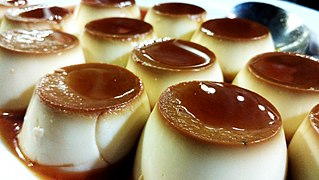
Crème caramel, flan, caramel pudding or caramel custard is a custard dessert with a layer of clear caramel sauce.

Dulce de leche, also known as caramelized milk or milk jam in English, is a confection from Latin America prepared by slowly heating sugar and milk over a period of several hours. The resulting substance, which takes on a spreadable, sauce-like consistency, derives its rich flavour and colour from non-enzymatic browning. It is typically used to top or fill other sweet foods.

Rice pudding is a dish made from rice mixed with water or milk and other ingredients such as cinnamon, vanilla and raisins.
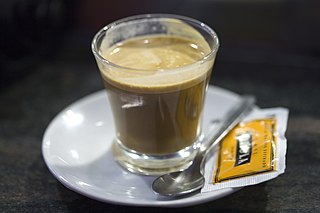
A cortado is a beverage consisting of espresso mixed with a roughly equal amount of warm milk to reduce the acidity. The milk in a cortado is steamed, but not frothy and "texturized" as in many Italian coffee drinks. The cortado comes from Spain, most likely Madrid, where it is commonly served.
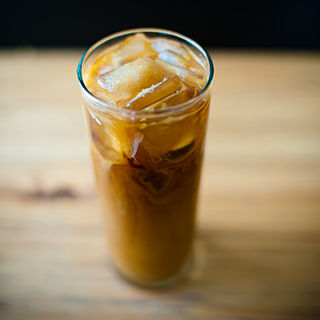
Iced coffee is a coffee beverage served cold. It may be prepared either by brewing coffee normally and then serving it over ice or in cold milk, or by brewing the coffee cold. In hot brewing, sweeteners and flavoring may be added before cooling, as they dissolve faster. Iced coffee can also be sweetened with pre-dissolved sugar in water.

Salvadoran cuisine is a style of cooking derived from the nation of El Salvador. The indigenous foods consist of a mix of Native American cuisine from groups such as the Lenca, Pipil, Maya Poqomam, Maya Chʼortiʼ, Alaguilac, Mixe, and Cacaopera peoples. Many of the dishes are made with maize (corn). There is also heavy use of pork and seafood. Old world ingredients were incorporated after the Spanish conquest.

Filipino cuisine is composed of the cuisines of more than a hundred distinct ethnolinguistic groups found throughout the Philippine archipelago. A majority of mainstream Filipino dishes that compose Filipino cuisine are from the food traditions of various ethnolinguistic groups and tribes of the archipelago, including the Ilocano, Pangasinan, Kapampangan, Tagalog, Bicolano, Visayan, Chavacano and Maranao ethnolinguistic groups. The style of food making and preparation, and the dishes associated with them, have evolved over many centuries from their Austronesian origins to a mixed cuisine of Chinese, Spanish and American influences, in line with the major waves of influence that had enriched the cultures of the archipelago, as well as others adapted to indigenous ingredients and the local palate.

Coquito meaning "Little Coconut" in Spanish is a traditional Christmas drink that originated in Puerto Rico. The coconut-based alcoholic beverage is similar to eggnog, and is sometimes referred to as Puerto Rican Eggnog. The mixed drink is made with Puerto Rican rum, coconut milk, cream of coconut, sweetened condensed milk, vanilla, nutmeg, clove, and cinnamon.

Manjar blanco, also known as manjar de leche or simply manjar, is a term used in Spanish-speaking area of the world in reference to a variety of milk-based delicacies. In Spain the term refers to blancmange, a European delicacy found in various parts of the continent as well as the United Kingdom. In the Americas it refers to a sweet, white spread or pastry filling made with milk. This term is sometimes used interchangeably with dulce de leche or cajeta in Latin America but these terms generally refer to delicacies prepared differently from those just described. Related dishes exist by other names in other countries, such as tembleque in Puerto Rico. In Portuguese-speaking countries the dish is known as manjar branco.

Sorbet, also called "water ice", is a frozen dessert made from sugar-sweetened water with flavoring – typically fruit juice, fruit purée, wine, liqueur or honey. Generally sorbets do not contain dairy ingredients, while the sherbets do.
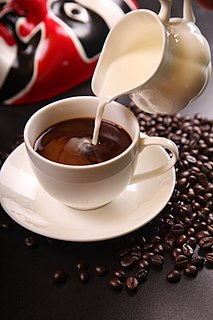
Milk coffee is a category of coffee-based drinks made with milk. Johan Nieuhof, the Dutch ambassador to China, is credited as the first person to drink coffee with milk when he experimented with it around 1660.
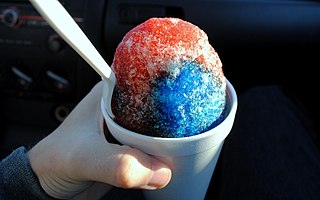
Shaved ice is a large family of ice-based desserts made of fine shavings of ice or finely crushed ice and sweet condiments or syrups. Usually, the syrup is added after the ice has been frozen and shaved—typically at the point of sale; however, flavoring can also be added before freezing. The dessert is consumed worldwide in various forms and ways. Shaved ice can also be mixed with large quantities of liquid to produce shaved ice drinks.

Natillas is a term in Spanish for a variety of custards and similar delicacies in the Spanish-speaking world. In Spain, this term refers to a custard dish made with milk and eggs, similar to other European creams as crème anglaise. In Colombia, the delicacy does not include eggs, and is called natilla.
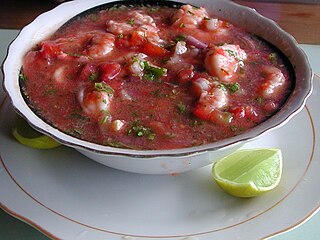
Ecuadorian cuisine is diverse, varying with altitude, and associated agricultural conditions. Ecuadorian cuisine is an amalgamation of Spanish, Andean, and Amazonian cuisines and to a lesser degree Italian, Lebanese, African, and Chinese. Beef, chicken, and seafood are popular in the coastal regions, specially ceviche; and are typically served with carbohydrate-rich foods, such as rice accompanied with lentils, pasta, or plantain, whereas in the mountainous regions pork, chicken, beef and cuy are popular and are often served with rice, maize, or potatoes. A popular street food in mountainous regions is hornado, consisting of potatoes served with roasted pig. Some examples of Ecuadorian cuisine in general include patacones, llapingachos, and seco de chivo. A wide variety of fresh fruit is available, particularly at lower altitudes, including granadilla, passionfruit, naranjilla, several types of banana, uvilla, taxo, and tree tomato.
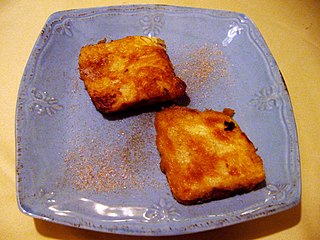
Leche frita is a Spanish sweet typical of northern Spain. It is made by cooking flour with milk and sugar until it thickens to a firm dough which is then portioned, fried and served with a sugar glaze and cinnamon powder.



















